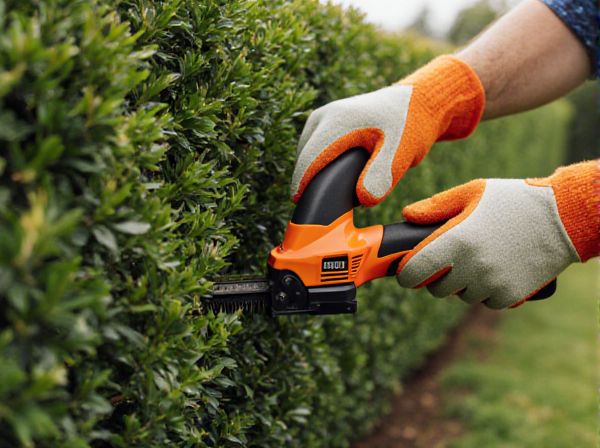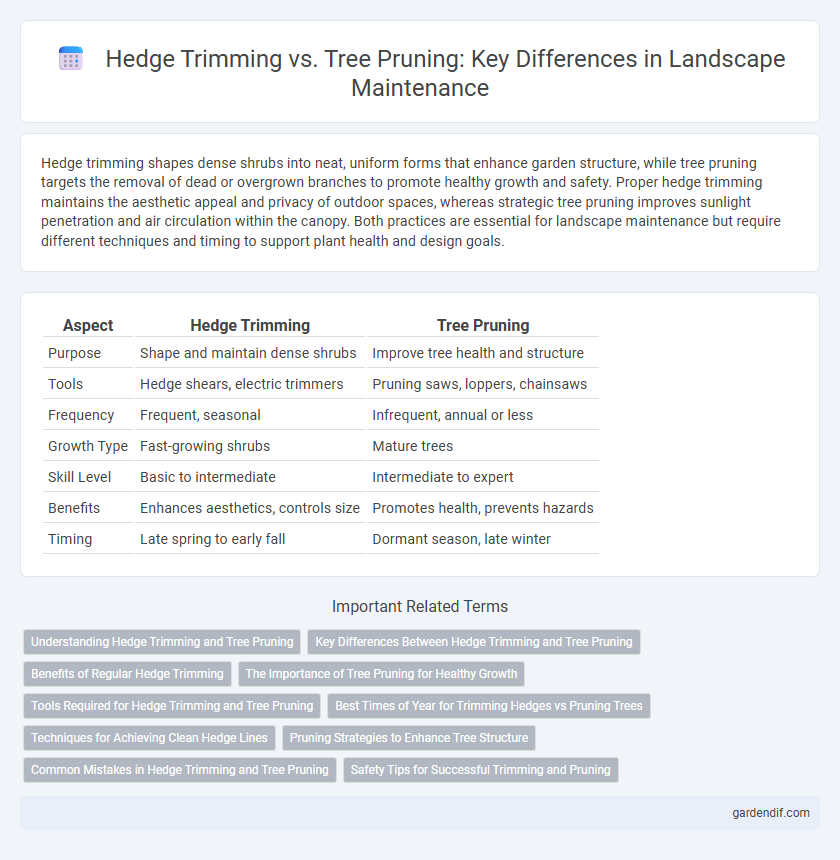
Hedge Trimming vs Tree Pruning Illustration
Hedge trimming shapes dense shrubs into neat, uniform forms that enhance garden structure, while tree pruning targets the removal of dead or overgrown branches to promote healthy growth and safety. Proper hedge trimming maintains the aesthetic appeal and privacy of outdoor spaces, whereas strategic tree pruning improves sunlight penetration and air circulation within the canopy. Both practices are essential for landscape maintenance but require different techniques and timing to support plant health and design goals.
Table of Comparison
| Aspect | Hedge Trimming | Tree Pruning |
|---|---|---|
| Purpose | Shape and maintain dense shrubs | Improve tree health and structure |
| Tools | Hedge shears, electric trimmers | Pruning saws, loppers, chainsaws |
| Frequency | Frequent, seasonal | Infrequent, annual or less |
| Growth Type | Fast-growing shrubs | Mature trees |
| Skill Level | Basic to intermediate | Intermediate to expert |
| Benefits | Enhances aesthetics, controls size | Promotes health, prevents hazards |
| Timing | Late spring to early fall | Dormant season, late winter |
Understanding Hedge Trimming and Tree Pruning
Hedge trimming involves shaping and maintaining dense, compact shrubbery to promote healthy, uniform growth and enhance garden aesthetics. Tree pruning focuses on selectively removing branches to improve tree structure, health, and safety by preventing disease and encouraging proper growth patterns. Both practices require specific tools and techniques tailored to plant species, growth stages, and landscape goals for optimal results.
Key Differences Between Hedge Trimming and Tree Pruning
Hedge trimming involves shaping and maintaining dense, bushy shrubs to promote uniform growth and aesthetic appeal, while tree pruning focuses on removing dead or diseased branches to enhance tree health and structure. Hedge trimming typically requires frequent, precise cuts to encourage thick foliage, whereas tree pruning is less frequent and aims to improve air circulation and sunlight penetration. The tools used differ as well: hedge trimmers and shears for hedges, versus pruning saws and loppers designed for larger tree branches.
Benefits of Regular Hedge Trimming
Regular hedge trimming promotes dense, healthy growth, enhancing privacy and aesthetic appeal in landscapes. It prevents overgrowth that can harbor pests and diseases, ensuring plant vitality and longevity. Consistent maintenance also shapes hedges for functional purposes such as windbreaks or noise reduction, improving overall garden structure.
The Importance of Tree Pruning for Healthy Growth
Tree pruning is crucial for maintaining the health and structural integrity of trees by removing dead or diseased branches that can hinder nutrient flow. Proper pruning techniques stimulate new growth, enhance sunlight penetration, and reduce the risk of pest infestations. Unlike hedge trimming, which primarily shapes and maintains bushes, tree pruning supports long-term vitality and optimal development of trees in any landscape.
Tools Required for Hedge Trimming and Tree Pruning
Hedge trimming requires tools like hedge shears, electric or gas-powered hedge trimmers, and sometimes pole trimmers for tall or wide hedges, designed for precise shaping of dense foliage. Tree pruning demands stronger equipment such as pruning saws, loppers, pole pruners, and sometimes chainsaws, tailored for cutting thicker branches and maintaining tree health. Proper tool selection enhances efficiency and ensures clean, healthy cuts for both hedges and trees.
Best Times of Year for Trimming Hedges vs Pruning Trees
Hedges are best trimmed in late spring and early summer when new growth is established but not fully matured, promoting dense foliage and shape. Trees benefit from pruning during late winter or early spring, while they are dormant, minimizing stress and reducing the risk of disease. Timing hedge trimming and tree pruning correctly ensures optimal growth, health, and aesthetic appeal in landscaping maintenance.
Techniques for Achieving Clean Hedge Lines
Hedge trimming employs shears or electric trimmers to create uniform, flat surfaces, ensuring clean hedge lines through consistent, frequent cuts. Tree pruning focuses on selective branch removal with pruning saws or loppers to maintain tree health and shape without compromising natural form. Precision and proper tool use are critical for achieving sharp, clean edges in both hedge trimming and tree pruning techniques.
Pruning Strategies to Enhance Tree Structure
Pruning strategies to enhance tree structure prioritize selective removal of branches to improve airflow, light penetration, and overall tree health. Techniques such as crown thinning and directional pruning help shape the tree, reduce risk of disease, and encourage strong branch development. Proper pruning timing aligned with species-specific growth patterns maximizes structural integrity and longevity.
Common Mistakes in Hedge Trimming and Tree Pruning
Common mistakes in hedge trimming include cutting too deeply, which can damage the plant's structure and reduce growth, and trimming unevenly, leading to unsightly shapes and poor air circulation. In tree pruning, frequent errors involve removing large branches improperly, resulting in excessive wound exposure and increased risk of disease or pest infestation. Both practices require precision and timing to avoid harming plant health and compromising landscape aesthetics.
Safety Tips for Successful Trimming and Pruning
Wear protective gear such as gloves, goggles, and sturdy footwear to prevent injuries during hedge trimming and tree pruning. Use appropriate tools like sharp shears for hedges and pruning saws for trees to ensure clean cuts and reduce strain. Always inspect branches for stability and avoid working near power lines to minimize accident risks.
Hedge Trimming vs Tree Pruning Infographic

 gardendif.com
gardendif.com